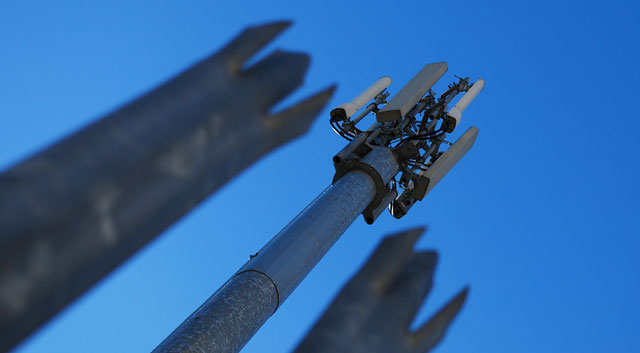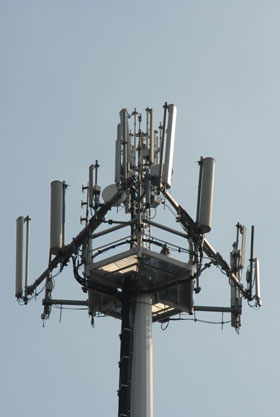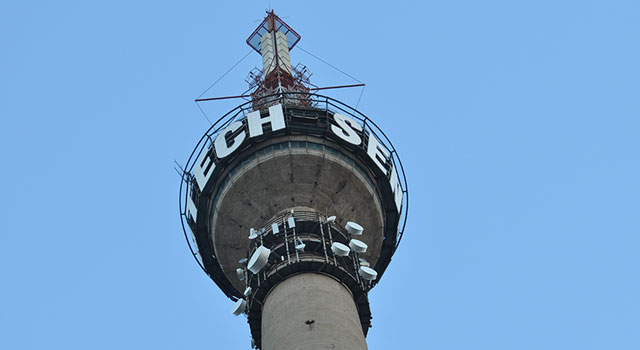
From the Northcliff water tower, you have a 360-degree view of Johannesburg. On a clear day, you can see all the way out to the Magaliesberg. The skyline landmark teeters on what was once called Aasvöelkop, the ridge where Matabeleland founder Mzilikazi stood before he headed north to Zimbabwe. Today, the area is the Northcliff Ecopark, a conservancy in the middle of the affluent suburb of Northcliff.
But go around the back of the towering grey structure and you’ll have another view of the place. There, in the distance, is a cluster of red and grey toothpicks, standing like sentinels on the boundary of the ecopark. Walk across the veld, and these toothpicks grow taller and taller until they tower over you and you realise what you are getting yourself into: a tiny forest of a half a dozen cellphone masts fitted with 300 to 400 antennas, which are in the business of transmitting and receiving voice and data signals from residents on the cliff and in the valleys below.
In battle, armies struggle for the high ground to gain the advantage over their enemies. But in the case of Northcliff, the vista is a curse. The outcrop is an ideal location for cellphone companies to expand their coverage area, but it is the placement of those masts and their antennas that has pitted neighbour against neighbour.
Murray Hewlett is leading the crusade against the spread of cellphone masts. He lives in a fortress just behind the houses where the owners have leased space on their own properties (many of which are adjacent the ecopark) to cellphone providers to put up their toothpick towers.
From the outside, Hewlett’s home looks quite normal, albeit expansive, with a grand, sweeping, white staircase ascending to a bright yellow double-storey house. But underneath its cheery veneer, Hewlett’s home is encased in steel plates that cover every inch of the exterior — expensive armour to fight off an invisible enemy: electromagnetic radiation.
When I was told a man had encased his home in R175 000 worth of steel to protect himself and his family from radiation, I expected to meet someone wearing a tinfoil hat with strategically placed antennas to ward off negative brainwave energy, with a collection of crystals hanging from his neck.
But Hewlett disappoints. He extends his hand, with a smile, and I can see my face reflected in his expensive-looking dark glasses. The glasses match a dark suit and shiny black shoes. Hewlett, a geneticist by training, is chief executive of an asset management company.
Unapologetic
The microwave radiation from these antennas, he says, is making residents sick and “every third household is suffering from cancer, nausea and mood swings”. He has gained support for his anti-mast crusade, which has polarised the community: those with towers versus those who believe that radiation is affecting their health and reducing property values in a suburb where an average home can fetch upwards of R2,5m. He says that he has the support of nearly 100 households, who have collectively raised about R40 000 for legal fees so far.
“People are dying. It is easy to get them to support [the legal battle], especially when they have no hair, no wife, no stomach,” he says, the latter referring to a man in the area who has had part of his stomach removed along with the cancer that was in it.
Hewlett says he has complained to the Independent Communications Authority of South Africa (Icasa), the cellphone companies and the City of Johannesburg, but has received “no joy”.
When the Mail & Guardian contacted the city about an application by Yolande Woolford-Le Roux to erect a cell mast on her property, the planning department requested more information because it “has received so many cell-mast application[s] from Northcliff and unfortunately, they cannot be sure which one you are referring to in this instance”. They replied: “No approval exists nor can our office recall any complaints referring to this site.”
“We have resorted to [using] attorneys,” says Hewlett. The attorneys have, in turn, specifically targeted the residents who have towers. Woolford-Le Roux is one of them. In fact, she appears to have become the target of a lot of the anti-cellphone tower vitriol in the neighbourhood.
This 46-year-old mother is unapologetic about trying to put a cellphone tower up on her property. At the moment, her home has only a mast and no antennas because of the legal action her neighbours have brought against her.
“It’s not like I do it for the money,” says Woolford-Le Roux. “I get R2 000/month for this thing, and it takes up quite a lot of space.” To be fair, one has to put that R2 000 into the context of a Northcliff lifestyle. If you were to buy a R2,5m house with a 100% bond over 20 years at an interest rate of 8,5%, your repayments would be about R27 000 a month, so R2 000 translates into chump change around here.
Besides, she says, she has a good reason for putting the mast in her yard. Two years ago she, along with her teenage children, was held up outside her home by five armed men.
“They held guns to my head, to my children’s heads,” she says. “They were here for half an hour … and we had no cellphone reception.”
Radiation control
She wanted to ensure she was never without reception again.
“People say there is going to be a war, that no one will be friends with you… I’ve been living here for 15 years and no one greets you anyway,” she says.
 Woolford-Le Roux works from home and says she would not have tried to put a mast on her property if there was a chance that it would hurt her or her children.
Woolford-Le Roux works from home and says she would not have tried to put a mast on her property if there was a chance that it would hurt her or her children.
“I think people are ignorant. I did my homework before I made a decision,” she says, adding that she did not take MTN’s word for it and consulted specialists from Stellenbosch about the matter. (Repeated attempts to contact MTN, which is erecting the mast on Woolford-Le Roux’s property, were unsuccessful.) The specialists assured her that the masts would not be detrimental, which happens to be the stance of the South African department of health as well as the World Health Organisation (WHO). The official stance of the WHO, according to its website, is that “to date, no adverse health effects have been established as being caused by mobile phone usage”.
This stance was reiterated by the health department in a memo written March 2011 by the department’s deputy director for radiation control.
But what happens when you multiply the numbers of masts and antennae?
Condemning antennas in general, says Hewlett, “would be like saying sunshine is bad for you. That’s nonsense, but if it’s magnified, it burns.”
The licensing of cellphone masts and base stations falls under Icasa, but its spokesman, Paseka Maleka, said that while the authority licenses cellular operators on a national scale, it does not regulate the placement of towers. Numerous follow-up questions to Maleka regarding the number of licences that have been awarded were not answered.
But Marnus Van Wyk, the director of EMSS Consulting, which assesses mast and antenna applications across the country, says the issue is not the number of masts, or even the number of antennas.
“It’s the systems and the power of the transmitters,” he says. “The number of antennas is not indicative of exposure. Fifteen microwave dishes can transmit less power than one television system,” he says, noting that EMSS has been involved in the majority of mast and antenna erection around the country and “when we leave a site, we do everything to make sure it is compliant”.
Meanwhile, Denis Warren-Tangney, the director of law firm Thomson Wilks in Sandton, who is acting for Hewlett and the residents’ association, says that this is one of two cellphone-mast matters being dealt with by the firm; the other one is in Fourways, also in Johannesburg.
“There is a lot of information gathering, and it is a long and slow process because there’s no legal precedent in this country,” Warren-Tangney says.
However, while health concerns are the first thing residents mention, he is arguing the case on the grounds of visual pollution and decreasing property values “because of the expense in proving health issues”.
“We have precedent regarding visual pollution and decrease in [property] value,” he says, and arguing health effects would “cost a fortune because we’d have to get medical specialists for each and every [resident blaming ill health on the cellphone masts]”.
While Vodacom is not involved in this particular legal wrangle, its spokesman, Richard Boorman, agreed to speak to the M&G. He said that people had fixated on the masts while cellphone devices create greater radiation exposure because they are held closer to the body.
Boorman hit back at the notion that the numerous masts and antennae could be causing sickness, noting that if that were the case, Brixton residents who live in the shadow of the 237m high Sentech tower would be filling Johannesburg’s hospitals because its signals are substantially stronger.
Significant broadcaster
Van Wyk explains it like this: radiation exposure depends on your position relative to the structure. So, because Sentech is a significant broadcaster, with a signal radius of more than 100km, its reach is much wider than cellphone antennas. His company’s 2009 information sheet on electromagnetic radiation from mobile phone base stations indicates that the “main beam” of radiation is perpendicular to the antenna and “typically points in the direction of the horizon”.
“The result is that only a very small percentage of the radiated energy will be present in the regions outside the main beam,” it reads. What that means in terms of the Sentech tower is that the “main beam” of radiation would be aimed at the horizon, rather than on the people below.
People in Northcliff are genuinely scared. But this seems to be a community that has been dogged by fear for years. A spate of violent crime has also terrorised the community. It was Hewlett, who now leases the area around the Northcliff water tower for the ecopark, who got the surrounding roads boomed off, including erecting big fences with only one entrance, making it more difficult for criminals to move around the area undetected.
Despite the antipathy between them, Woolford-Le Roux gives Hewlett credit for making the suburb safer: “Murray succeeded in closing off the area, and I’m thankful.”
Many residents are finding a sense of community in the crusade against cellphone towers.

Alex Rutte, who lives in Louie Avenue, says that while he does not “know a lot about cell-mast technology … the aesthetics of such a structure are definitely an issue, especially in an area where homes are expensive.” He also points to the “serious health concerns”, but, like most in the area, he does not give specifics.
Are the health concerns regarding cellphone radiation well founded?
In 2011, the International Agency for Research on Cancer, a unit of the WHO, classified cellphone radiation as “group 2B”, which means it is “possibly carcinogenic”. Critics read this as “cellphones cause cancer” and proponents read it as “cellphones don’t harm people”. But it’s difficult to read this carcinogen as a real threat. After all, substances included in “group 2B” also to include coffee, pickled vegetables and titanium dioxide, which is found in toothpaste.
Accepted science
A Danish study in 2004 conducted by the Institute of Cancer Epidemiology in the Danish Cancer Society and which was published in the peer-reviewed Journal of the National Cancer Institute in 2006 assessed incidences of cancer among cellphone users. For 21 years, the research followed more than 420 000 people who took out cellphone subscriptions between 1982 and 1995 — making it the largest study to date. It found no increased risk of cancer.
The Interphone project, a collaboration among 13 nations made up of 21 scientists and commissioned by the WHO’s International Agency for Research on Cancer, had similar results. It found no link between cellphone usage and brain tumours.
Of the project’s €19,2m funding, about €5,5m came from industry sources, the WHO noted upon the release of the findings of the study, which involved more than 5 000 brain cancer patients. Similar studies have been undertaken in Britain, Sweden and Germany — producing similar results.
But Hewlett is dissatisfied with the accepted science, and points to a group called BioInitiative and its 2013 report. According to its website, the report “has been done independent of governments, existing bodies and industry professional societies that have clung to old standards” and was compiled by “29 authors from 10 countries, 10 holding medical degrees, 21 PhDs and three [master’s degrees]”. Their research has found that electromagnetic radiation causes neurological and gene damage, is a risk factor for Alzheimer’s Disease, can damage sperm and impair foetal development and can cause cancer.
Hewlett stands by the BioInitiative report rather than those of government health authorities, saying that governments are swayed by industry. Without disclosing names, he shows me 50 survey responses from residents as proof that people in the community are ill. Some of the responses tick every ailment — from headaches to nausea to insomnia — while others report no complaints at all. A cursory glance through the responses does not reveal anything conclusive and it is not possible to say whether the majority of residents believe they are sick.
Hewlett has a machine that measures the strength of the electric field, a Geiger counter for microwave radiation. These devices, called microwave power meters, are usually used in industry to detect microwave radiation leakage in operations, or by consumers to check whether their microwave is faulty. It is yellow and looks like a thick scientific calculator.
He maintains that “some first-world countries” have a minimum radiation level of 20 millivolts per metre (mV/m) in urban areas. Outside his house the counter spikes into the thousands, peaking at 16 000mV/m. Inside the steel-clad walls and behind the reflective windows, the reading drops to about 600mV/m. I am suitably horrified and want to leave the area as soon as possible.
But back at my desk I looked up standard limits for radiation-exposure levels. The guidelines of the International Commission for Non-Ionising Radiation Protection — a non-profit scientific organisation based in Germany — which South Africa adheres to, say the maximum radiation is 87 000mV/m, meaning that, at 16 000mV/m, if Hewlett’s machine is right, the Northcliff area is well below the international standard.
Home improvements
This guideline, as laid out in a 1998 report on non-ionising radiation, stipulates these numbers because at higher radiation levels, the body’s temperature increases. The maximum threshold of 87 000mV/m is when the radiation raises the body’s temperature by more than a degree, which is dangerous to the normal function of health and cells.
But Hewlett is not convinced by official platitudes, studies or some doctor telling him it’s all going to be okay. He says that big business is putting pressure on regulators and research bodies. In fact, he says, as soon as the case was brought against Woolford-Le Roux, MTN’s lawyers stepped in, something which she herself admits.
“You’ll never win against cellphone companies,” he says, likening it to fighting tobacco companies. A case against a cellphone company about the possibly damaging effects of radiation has not gone to court in South Africa, it is always settled out of court beforehand, so there is no legal precedent, something which is echoed by his lawyer, Warren-Tangney.
Vodacom’s Boorman also says that, to his knowledge, there has been no case of this nature against a cellphone company. Cell C said: “While we have had some objections [or] complaints, there has been no litigation.”
To date, no personal injury lawsuits against cellphone providers have been won in the US, although a number have been brought before the court.
Hewlett will not be deterred from his mission. “I spend enough money to make myself and my family safe,” he says.
His bill has already topped R350 000 and, without breaking the amount into specifics, his fortress is not yet complete. A coating of specialised paint from Germany will be the final finish on the house’s armour. When asked whether his home improvements have made a difference, he says he is living proof.
“We had headaches, nausea, insomnia, our two-day old baby started to pop out teeth at the same time as I discovered two precancerous moles on my arm,” he says, rubbing the area to show where they were. “The instant I put up the shielding, they were gone.” — (c) 2013 Mail & Guardian
- Visit the Mail & Guardian Online, the smart news source
- Follower writer Sarah Wild on Twitter




